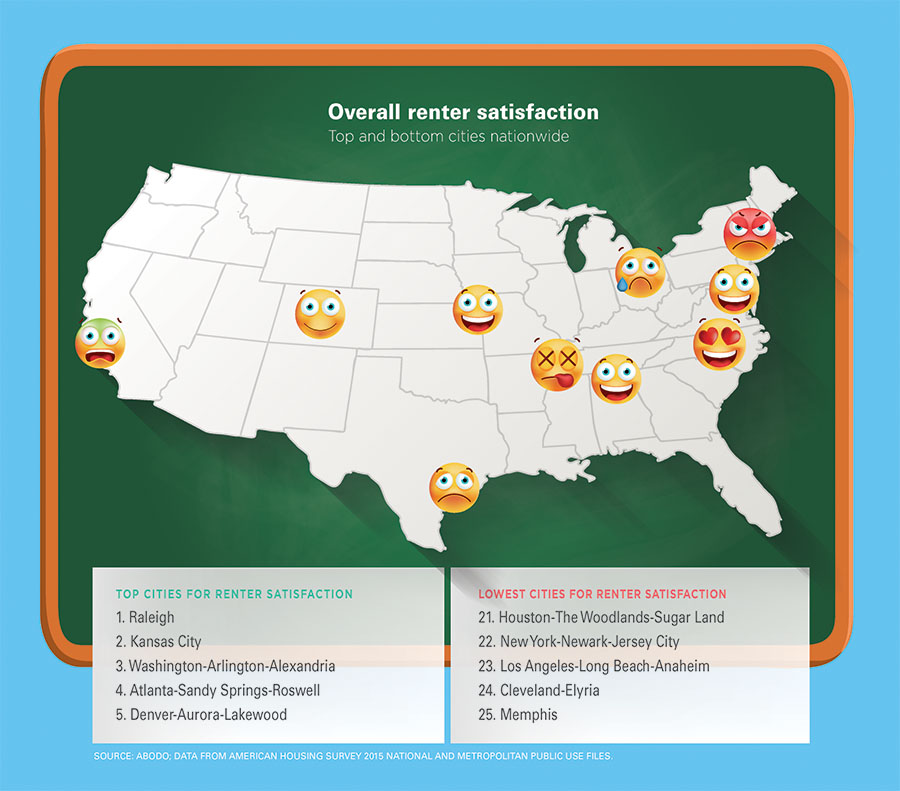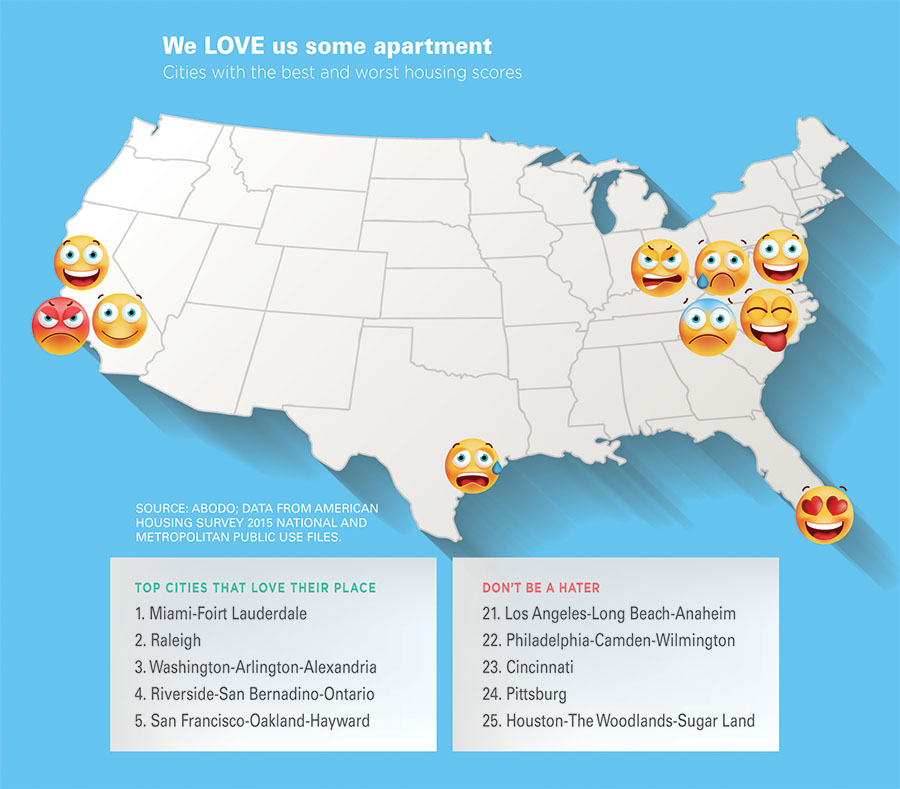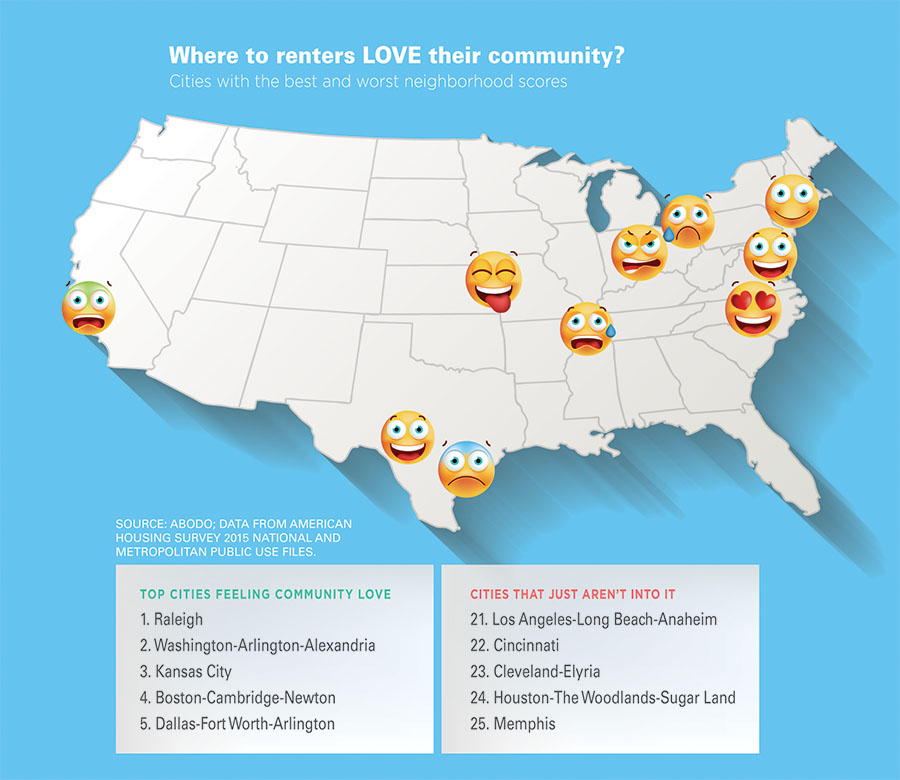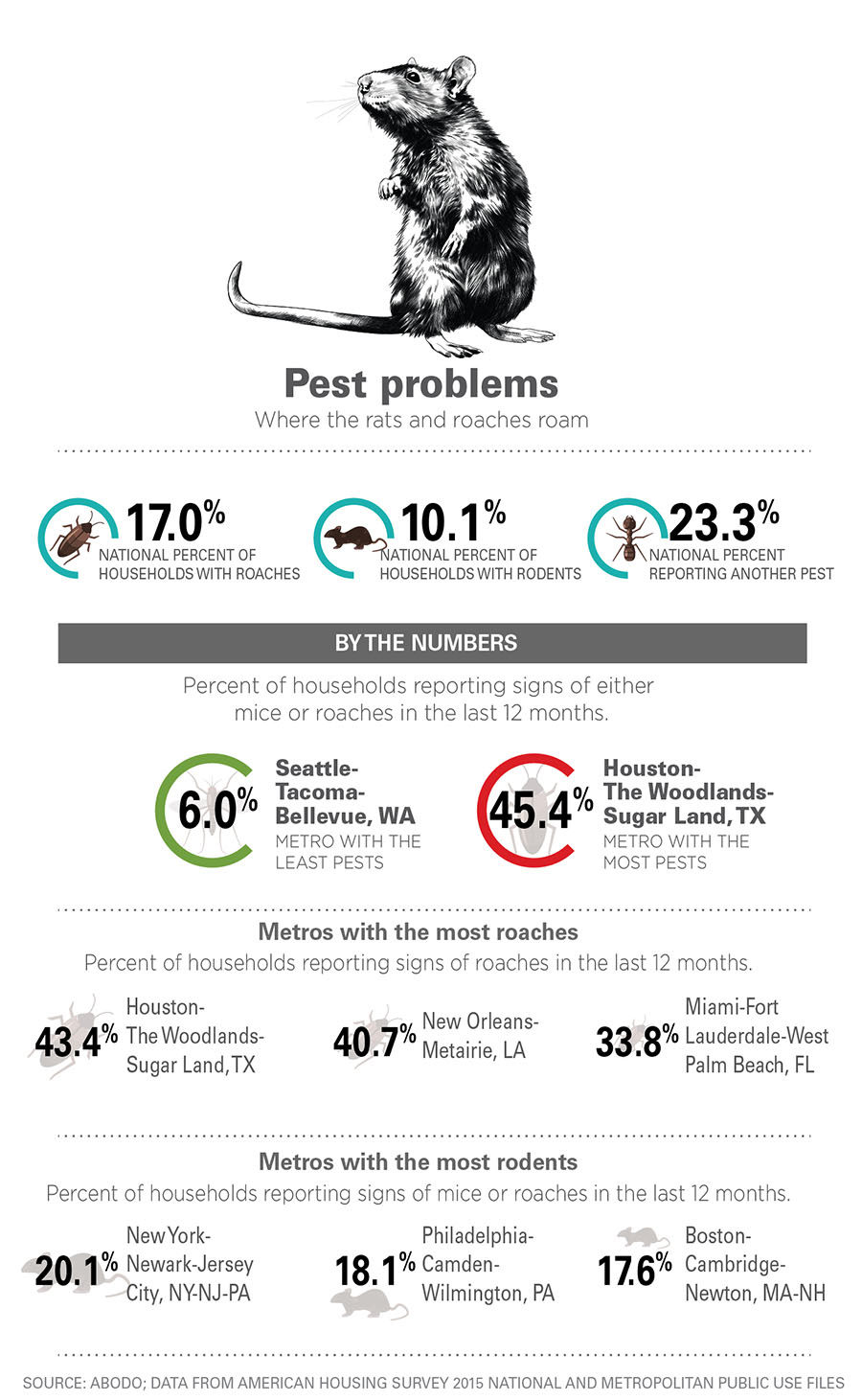Where do renters most enjoy renting? With data from the 2015 American Housing Survey, we were able to crunch the numbers on the cities where renters have the most (and fewest) issues with their apartments and their neighborhoods. We wanted to find the American cities where renters are the most satisfied with their homes—and those cities where they’re not.

Define satisfaction
What does it mean to be a satisfied renter, exactly? Being pleased (or displeased) with your living arrangement is typically the result of a melange of details ranging from hard facts, like location and price, to softer sentiments, such as whether you feel like your neighborhood is safe.
For our renter satisfaction scoring, we looked at a range of indicators across two categories: neighborhood and home.
For neighborhood satisfaction, we drew from the U.S. Census’ American Housing Survey of 25 metro areas and considered renters’ own opinions of their area’s crime, schools, public transportation, litter, and overall rating of the neighborhood.
For their own rented units, whether they’re apartments or single-family homes, we considered issues ranging from rodents and roaches, to heating issues, mold, water leaks, and more significant structural problems, like missing walls and holes in the roof.
We’ll tackle each of those categories in turn, but first, let’s combine them with rent affordability for an overall look at which metro areas have the most satisfied renters.
Raleigh, N.C., comes out on top with a total score of 275 out of 300. The only other metro area to break the 200-point threshold is Kansas City, Mo.-Kan., with 232 points. The rest of the top five include Washington-Arlington-Alexandria, D.C.-Va.-Md.-W.V. (199); Atlanta-Sandy Springs-Roswell, Ga. (194); Denver-Aurora-Lakewood, Colo. (194); and Boston-Cambridge-Newton, Mass.-N.H. (185).
Down in eleventh place is Pittsburgh, Pa., with a score of 163, despite having the highest affordability score of all 25 metro areas. The next two most affordable cities are our overall top two cities—Kansas City and Raleigh—followed by Houston-The Woodlands-Sugar Land, Texas; and Cincinnati, Ohio-Ky.-Ind.
Bringing up the rear, renters in Memphis, Tenn.-Miss.-Ark., are the least satisfied overall, with a total score of 65 out of a possible 300. Cleveland-Elyria, Ohio (76); Los Angeles-Long Beach-Anaheim, Calif. (83); New York-Newark-Jersey City, N.Y.-N.J.-Pa. (95); and Houston-The Woodlands-Sugar Land (97), are the only other five areas to score less than 100 total points.
New York-Newark-Jersey City and Los Angeles-Long Beach-Anaheim were undoubtedly dinged for their low affordability scores (of just 8 and 4 out of 100, respectively), but our least affordable city on our list is Miami-Fort Lauderdale-West Palm Beach, Fla.

Renters in love
High rent aside, Miami renters love their apartments, earning the highest home satisfaction score. It’s no surprise that our overall satisfaction first-place city of Raleigh also scores highly with an 83 out of 100, earning the second spot. Washington-Arlington-Alexandria (81), Riverside-San Bernardino-Ontario, Calif. (73); and San Francisco-Oakland-Hayward, Calif. (70) round out the top five.
These cities reported the fewest structural and cosmetic problems, and renters gave their homes high marks.
Earlier, we noted that Houston-The Woodlands-Sugar Land had one of the best affordability scores in the country—and that’s a good thing, considering that the metro falls in last place for renter home satisfaction. Among other unpleasantries, renters in Houston gave their dwelling the lowest average rating (7.3 out of 10) and reported the most broken or boarded up windows (which 11.3 percent of surveyed Houston renters reported), as well as some of the most reports of missing wall material (6 percent) and mold (6.5 percent).
Pittsburgh (19); Cincinnati (25); Philadelphia-Camden-Wilmington, Pa.-N.J.-Del.-Md. (33); Dallas-Fort Worth-Arlington, Texas, and New York-Newark-Jersey City (both tied with 34) also scored poorly. The New York area scored the worst in two categories: being uncomfortably cold for 24 hours or more (19.4 percent), and not having a working toilet at some point in the last three months (5.7 percent).
Of course, these experiences aren’t unanimous, and even in cities with the most reports of problems, the numbers still aren’t overwhelming. For example, rainy Seattle-Tacoma-Bellevue, Wash., had the most renter reports of mold—but it’s just 8.7 percent of renting households.

Cities where renters love their neighborhoods
Raleigh comes out on top again for neighborhood satisfaction. The only category that gave Raleigh real trouble was public transportation. Just 40.7 percent of renters in Raleigh think their neighborhood has a good bus, subway, or commuter bus service, which is the worst score of all 25 cities. The only other factor for which Raleigh didn’t get top marks was for its schools: 76.7 percent think their neighborhood has good schools, the fourth-best school score, while Kansas City was the most confident, with 79.6 percent.
The Washington, D.C. (89) and Kansas City (87) areas, as always, follow closely behind Raleigh, in second and third place. In fourth place, Boston-Cambridge-Newton, Mass.-N.H. (86), makes its first appearance in the top five. Dallas-renters might not love their apartments, but, as it turns out, they do love their neighborhoods: Dallas-Fort Worth-Arlington comes in fifth place, with a score of 75. Atlanta and Denver tie for sixth with 71.
Memphis is firmly in last place for neighborhood satisfaction among renters, with the most reports of petty crime (40 percent) and serious crime (23.1 percent), and the second-most reports of vandalized/abandoned buildings within a half-block (18.5 percent).
Houston-The Woodlands-Sugar Land isn’t far behind, with just 9 out of 100 points. The area ranks relatively poorly for each neighborhood factor, but doesn’t take the cake on any of them. Cincinnati was rated the most poorly by its renters, who scored it 7.3 out of 10—for reference, our winner, Raleigh, was given a neighborhood rating of 8.1 by its renters. San Francisco-Oakland-Hayward was the hardest on its schools, with only 66.1 percent believing they have a good school nearby.
The Los Angeles area, which landed in the bottom five, is the trashiest city in our ranking: 20.2 percent of renters report a small or large amount of trash, litter, or junk laying around within a half-block.
Pest problems
A great neighborhood might make up for a dingy kitchen. You might be OK with the occasional leaky pipe if your bathroom is palatial. But even the most beautiful bedroom in the world can’t save an apartment with rats or roaches.
Almost a quarter of the country’s renters report pests of some kind in their apartments. Houston-The Woodlands-Sugar Land renters report having seen evidence of mice or cockroaches in the previous 12 months at double the national figure and the highest in the country.
The American Housing Survey tracks pests by type: rats/mice and cockroaches. The worst cities for roaches are in the wet and humid South with Houston-The Woodlands-Sugar Land rating the worst in the country. When it comes to rats and mice, the East Coast takes the lead with New York-Newark-Jersey City at the top.

What does this all mean?
Why do renters love their apartments? Why do they want to move?
A lot of what makes a home a home is personal and unquantifiable. It’s difficult to assign a number to a neighborhood’s strong sense of community, or to explain why some cities just “feel right” for certain people.
But if our data has shown us anything, it’s that certain cities are more favorable renting environments than others. And it turns out that price isn’t the only factor—renters, like homeowners, care about quality. They care about local schools and public transportation; they want safe streets and clean sidewalks. The cities that best address such renters—like Raleigh, near the top in every category—provide high-quality, affordable housing within an urban environment where renters feel served by local city infrastructure.
Nearly 37 percent of Americans rent, and their numbers are growing. As American cities continue to expand, city planners and developers would do well to follow Raleigh’s example, and heed the concerns of a growing renter base comprising Americans from a variety of backgrounds, ages, and income levels.
Author: Sam Radbil, Abodo. For methodology.















